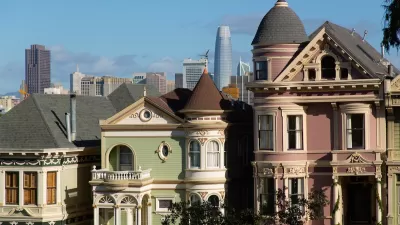As wealthy communities learn to use historic districts to inflate property values, socially conscious urbanists must think twice about the purpose and place of preservation, Will Doig reports.
The popular image of New Urbanism as a movement centered on local character and human scale lines up nicely with the themes of historic preservation. But when it comes to protecting old neighborhoods, the lines of alliance and opposition are shifting, on account of new trends in how and why communities push for historic designation.
As Doig explains, New York's Greenwich Village tells the story of this sea change: "Fifty years ago, a high-rise urban-renewal project threatened to eviscerate the neighborhood. But local activists successfully quashed it, and the Village, now one of Manhattan's most desirable neighborhoods, has enjoyed historic designation since 1969." And now, after two expansions to the historic district (in 2006 and 2010) and with average apartment prices rising above $2 million, the Preservation League of New York State is pushing to expand it yet again.
Quoting sociologist David Harvey, Doig warns that these moves are turning Manhattan into "the world's biggest gated community," noting the patently anti-New Urbanist outcomes that historic districting can bring about. "Restricting development in pricey neighborhoods, the new thinking goes, not only cements a city's best sections as enclaves for the rich, it has wider anti-urban reverberations. It promotes suburbanization by pricing out the middle class. It prevents densification, the greenest, most efficient use of space and the defining characteristic of cities."
But as Doig points out, the philosophy has its detractors, too: preservation architect Jeffrey Chusid has "written about a working-class historic district in Austin, Texas, whose protected status has helped prevent speculative land grabs." And journalist Roberta Brandes Gratz "says the market itself shows that people like these neighborhoods as they are."
The question, ultimately, is whether history can hold up as an excuse to shield whole tracts of the city from the needs of its present-day citizens.
FULL STORY: Preserving history, or the 1 percent?

Maui's Vacation Rental Debate Turns Ugly
Verbal attacks, misinformation campaigns and fistfights plague a high-stakes debate to convert thousands of vacation rentals into long-term housing.

Planetizen Federal Action Tracker
A weekly monitor of how Trump’s orders and actions are impacting planners and planning in America.

San Francisco Suspends Traffic Calming Amidst Record Deaths
Citing “a challenging fiscal landscape,” the city will cease the program on the heels of 42 traffic deaths, including 24 pedestrians.

Defunct Pittsburgh Power Plant to Become Residential Tower
A decommissioned steam heat plant will be redeveloped into almost 100 affordable housing units.

Trump Prompts Restructuring of Transportation Research Board in “Unprecedented Overreach”
The TRB has eliminated more than half of its committees including those focused on climate, equity, and cities.

Amtrak Rolls Out New Orleans to Alabama “Mardi Gras” Train
The new service will operate morning and evening departures between Mobile and New Orleans.
Urban Design for Planners 1: Software Tools
This six-course series explores essential urban design concepts using open source software and equips planners with the tools they need to participate fully in the urban design process.
Planning for Universal Design
Learn the tools for implementing Universal Design in planning regulations.
Heyer Gruel & Associates PA
JM Goldson LLC
Custer County Colorado
City of Camden Redevelopment Agency
City of Astoria
Transportation Research & Education Center (TREC) at Portland State University
Jefferson Parish Government
Camden Redevelopment Agency
City of Claremont





























